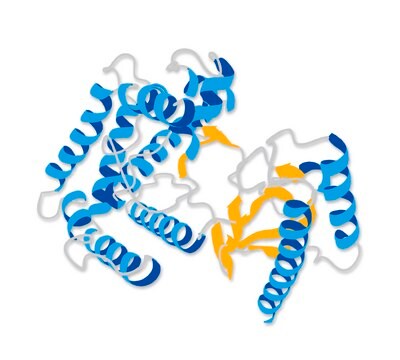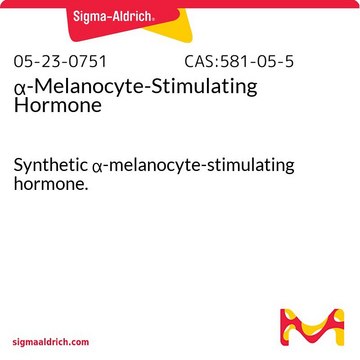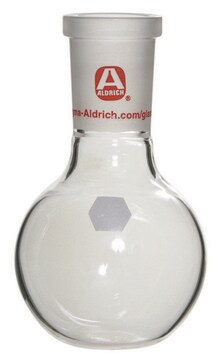SRP3318
C1 Inhibitor Peptide
≥95% (HPLC), lyophilized powder, human recombinant, expressed in CHO cells
Sinónimos:
C1inh, Plasma protease C1 inhibitor, Serpin G1
Iniciar sesiónpara Ver la Fijación de precios por contrato y de la organización
About This Item
UNSPSC Code:
12352202
NACRES:
NA.32
Productos recomendados
Nombre del producto
C1 Inhibitor human, recombinant, expressed in CHO cells, ≥95% (SDS-PAGE), ≥95% (HPLC)
biological source
human
recombinant
expressed in CHO cells
assay
≥95% (HPLC)
≥95% (SDS-PAGE)
form
lyophilized
potency
≤2.6 nM IC50
mol wt
52.8 kDa
packaging
pkg of 200 μg
impurities
endotoxin, tested
UniProt accession no.
shipped in
wet ice
storage temp.
−20°C
Gene Information
human ... SERPING1(710)
General description
Plasma protease C1 inhibitor is a member of the serpin family of structurally related proteins. Recombinant Human C1 inhibitor is a highly glycosylated glycoprotein containing 478 amino acid residues (52.8kDa), corresponding to amino acids 23-500 of the C1 inhibitor precursor, and is fully functional in its ability to inhibit the C1 complex. Glycosylated C1 inhibitor migrates at an apparent molecular weight of approximately 80-90kDa by SDS PAGE analysis under reducing conditions.
Biochem/physiol Actions
Plasma protease C1 inhibitor is the primary regulator of the immune complement system. C1 inhibitor is a protease inhibitor that functions to inhibit the complement system in order to prevent over-activation or spontaneous activation. Inhibition is achieved by binding to and irreversibly inhibiting the C1r and C1s proteases of the C1 complex, which has the effect of shutting down all subsequent downstream events in the complement activation cascade. C1 inhibitor can also inhibit various other proteases, including Kallikrein, Factor XIa, and Factor XIIa. Deficiencies in C1 inhibitor are the primary cause of hereditary angioedema (HAE, hereditary angioneurotic edema), a disease characterized by edema in the respiratory and gastrointestinal tracts. In certain clinical situations, the direct administration of C1 inhibitor can be used to treat HAE and certain other conditions.
Physical form
Lyophilized from 10mM Sodium Phosphate, pH 7.5.
Reconstitution
Centrifuge the vial prior to opening. Reconstitute in water to a concentration of 0.1-1.0 mg/ml. Do not vortex. This solution can be stored at 2-8°C for up to 1 week. For extended storage, it is recommended to further dilute in a buffer containing a carrier protein (example 0.1% BSA) and store in working aliquots at -20°C to -80°C.
Storage Class
11 - Combustible Solids
wgk_germany
WGK 3
flash_point_f
Not applicable
flash_point_c
Not applicable
Elija entre una de las versiones más recientes:
¿Ya tiene este producto?
Encuentre la documentación para los productos que ha comprado recientemente en la Biblioteca de documentos.
C1 inhibitor.
A E Davis et al.
Methods in enzymology, 223, 97-120 (1993-01-01)
C1-inhibitor deficiency and angioedema.
Carugati A
Molecular Immunology, 38(2-3), 161-173 (2001)
C1 Esterase Inhibitor (Human)
P & T : A Peer-Reviewed Journal for Formulary Management, 35, 2-3 (2010)
Sayani Mukherjee et al.
The Journal of neuroscience : the official journal of the Society for Neuroscience, 40(41), 7965-7979 (2020-09-06)
Microglia, a type of CNS immune cell, have been shown to contribute to ethanol-activated neuronal death of the stress regulatory proopiomelanocortin (POMC) neuron-producing β-endorphin peptides in the hypothalamus in a postnatal rat model of fetal alcohol spectrum disorders. We determined
In vivo biosynthesis of endogenous and of human C1 inhibitor in transgenic mice: tissue distribution and colocalization of their expression.
Vinci G
Journal of Immunology, 169(10), 5948-5954 (2002)
Nuestro equipo de científicos tiene experiencia en todas las áreas de investigación: Ciencias de la vida, Ciencia de los materiales, Síntesis química, Cromatografía, Analítica y muchas otras.
Póngase en contacto con el Servicio técnico








